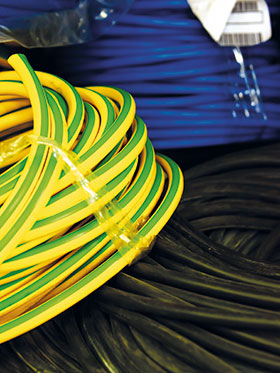

Cables used for the purpose of fire detection differ from cables used for other services. Fire alarm cables are designed to operate during the fire condition and not to fail in the event of high temperatures imposed on them. These cables are carrying power and data to alarm sounders and visible fire indications during the course of the fire to ensure people in all areas of the building can evacuate safely.
SANS 10139 Section 8.19 has recommendations on cable choice. The standard makes recommendations for two levels of fire resistance of fire resisting cable systems, termed ‘standard’ and ‘enhanced’, according to the type of building and fire alarm system installed:
• The use of cables with ‘standard’ fire resistance is recommended for general use.
• The use of cables with ‘enhanced’ fire resistance is recommended for systems, in particular building types, in which cables might need to operate correctly during a fire, for periods in excess of those normally required for single phase evacuation of a building.
The distinction between the two levels of performance is, therefore, made in this standard to enable designers and specifiers to specify ‘enhanced’ performance cables in situations in which it is considered that a higher level of fire resistance is desired.
Standard fire resisting cables should meet the PH 30 classification when tested for 30 minutes survival time, when exposed to 840°. Enhanced fire resisting cables should meet the PH 120 classification when tested for 120 minutes survival time, when exposed to 840°C.
All conductors should have a cross-sectional area of at least 1.00 mm2.
Cable support should be non-combustible and such that circuit integrity will not be reduced below that afforded by the cable used, and should withstand a similar temperature and duration to that of the cable, while maintaining adequate support. The material from which fixings are made from is of utmost importance.
Plastic cable clips, plastic cable ties and PVC trunkings should not be used as the sole means of cable support. Plastic cable fixings should only be used for fixing where cables run on top of or in horizontal metal trays. PVC conduit is permitted if special attention is given to the support method of the conduit so as to prevent the collapse of the cable network under fire conditions: i.e. conduit supports should be non-combustible (for example steel). The distance between the conduit supports should not exceed 500 mm.
Mineral insulated copper sheathed cables and steel wire armoured cables maybe used throughout all the parts of a building without additional mechanical protection except in particularly arduous conditions.
To avoid the risk of mechanical damage to fire alarm cables, they should not be installed within the same conduit as the cables of other services. Where fire alarm cables share common trunking, a compartment of the trunking, separated from other compartments by a strong, rigid and continuous partition, should be reserved solely for fire alarm cables.
Cables should be installed without external joints wherever practicable.
Where jointing of cables is unavoidable then the terminals used to joint the cables should be of material that will withstand a similar temperature and duration of the temperature to that of the cable itself. The joints should be enclosed within junction boxes, labelled with the words ‘FIRE ALARM’ to assist in the identification of fire alarm circuits.
To avoid electromagnetic interference with fire alarm signals, any recommendations by the manufacturer of the fire alarm equipment in respect of separation of fire alarm cables from the cables of other services should be followed.
Multicore cable is not recommended for fire alarm systems.
All fire alarm cables should be preferably red in colour to enable these cables to be distinguished from those of other circuits. Another colour may be used provided the same colour is not used for cables of other electrical services in the same building.
All fire alarm cable outer sheaths should be marked in order to identify the cables. Markings should include the following:
• The manufactures name, trade name or trademark.
• The year of manufacture.
• The cable description.
• The fire rating of the cable along with the test method used.
• The batch number.
We highly recommend the use of FDIA companies for design and installation of fire alarm systems as it provides an element of comfort to end-users knowing they understand and comply with all the requirements of these standards.
Low smoke, zero halogen
Following testing of fire alarm cables by the FDIA it was noticed that some of the cables were not halogen free. This could be due to the fact that SANS 10139 errs as it does not specify “low smoke, halogen free” and manufacturers have taken the gap to reduce costs.
In a fire, a chlorine-containing plastic material releases hydrogen chloride, a poisonous gas that forms hydrochloric acid when it comes in contact with water. Cables that are not halogen free create noxious, corrosive gas when exposed to flame. These noxious gases lead to dangerous atmospheres for human beings.
Designated halogen-free cables, that are the norm in other parts of the world, do not produce a dangerous gas/acid combination when exposed to flame. Low smoke, zero halogen cable reduces the amount of toxic and corrosive gas emitted during combustion.
We plead with all designers of fire detection systems to add the words “LOW SMOKE, ZERO HALOGEN” to your cable specifications to ensure we provide a safe environment for the South African public.
For more information contact FDIA, [email protected], www.fdia.co.za
© Technews Publishing (Pty) Ltd. | All Rights Reserved.